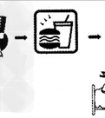按要求完成下列各句。1. Isshegoingtoschool _____________ hospital? (用适当的连词填空)2. Theyareplayingfootball. (改为一般疑问句)______________________________-六年级英语
题文
| 按要求完成下列各句。 |
| 1. Is she going to school _____________ hospital? (用适当的连词填空) 2. They are playing football. (改为一般疑问句) _______________________________________________________________________ 3. Will he be twelve next year? (作否定回答) _______________________________________________________________________ 4. Miss Yang is talking to Mary. (就画线部分提问) _______________________________________________________________________ 5. You can not smoke here. (改为祈使句) _______________________________________________________________________ |
答案
| 1. or 2. Are they playing football? 3. No, he won't. 4. Whom is Miss Yang talking to? 5. Don't smoke here! |
据专家权威分析,试题“按要求完成下列各句。1. Isshegoingtoschool _____________ hos..”主要考查你对 连词,疑问代词,一般疑问句,祈使句 等考点的理解。关于这些考点的“档案”如下:
连词疑问代词一般疑问句祈使句
考点名称:连词
- 连词:
是连接单词、短语或句子的一种词,连词不能独立担任句子成份,而只起连接作用。
连词可分为两大类:并列连词和从属连词。 - 连词的用法:
一、并列连词:
1.and连接单词MybrotherandIstudyinthesameschool。
连接短语Ourknowledgemaycomefromthebooksandfrompractice。
连接句子Wearesingingandtheyaredancing。
2but但是/而是Ihaveapenbutnopencil.or或者Willyougotherebybusoronfoot
3.nothingbut除了,只有Ididnothingbutwatchit。
4.or表示否则Hurryuporyouwillbelate。
5.for表示因为Heisgoodatmathforhestudiesharderthanothers。
二、从属连词:
1.after表示“时间”,在…之后
AfterIfinishedtheschool,Ibecameaworkerinthefactory。
2.although/though表示让步,“尽管”Althoughsheisyoung,sheknowsalot。
3.as表示时间,“当…时”,方式“象…”,原因,“由于、因为”让步,“尽管、虽然”
Asitwaslate,wemustgonow。
4.asif/asthough表方式,“似乎、好像”
Hetoldissuchastoryasthoughhehadbeentherebefore。
5.aslongas/solongas表条件,“只要”AslongasIamfree,I’llgotohelpyou。
6.assoonas表时间,“一…就…”IwillphoneyouassoonasIcomeback。
7.because表原因,“因为”IhavetostayinbedbecauseIamill。
8.before表时间,“在…之前“Youshouldthinkmorebeforeyoudoit。 比较and和or
①并列结构中,or通常用于否定句,and用于肯定句。
②但有时and 也可用于否定句。请注意其不同特点:
There is no air or water in the moon.
There is no air and no water on the moon.
在否定中并列结构用or 连接,但含有两个否定词的句子实际被看作是肯定结构,因此要用and。
比较so和 such
其规律由so与such的不同词性决定。
such 是形容词,修饰名词或名词词组;
so是副词,只能修饰形容词或副词;
so 还可与表示数量的形容词many,few,much, little连用,形成固定搭配。
so + adj. such + a(n) + n.
so + adj. + a(n) + n. such + n. (pl.)
so + adj. + n. (pl.) such +n. (pl.)
so + adj. + n. [不可数] such +n. [不可数]
so foolish such a fool
so nice a flower such a nice flower
so many/ few flowers such nice flowers
so much/little money. such rapid progress
so many people such a lot of people
so many 已成固定搭配,a lot of 虽相当于 many,但 a lot of 为名词性的,只能用such搭配。
so…that与such…that之间的转换既为 so与such之间的转换。- 小学阶段常见的连词:
(1)and(和)表示并列和对称
例:I like basketball and football. 我喜欢篮球和足球。
She likes singing and dancing. 她喜欢唱歌和跳舞。
(2)or(或者,还是)表示选择。(常出现在选择疑问句中)
例:Is it big or small?
(3)if(如果……)表示条件。
例:We will go to the zoo if it does not rain tomorrow. 如果明天不下雨,我们就去动物园。
(4)because(因为……)表示原因。
例:John doesn’t come to school today because he is ill. 约翰今天没来上学,因为他病了。
Li Lei was late for class because he got up late. 李雷上课迟到了,因为他起床迟了。
(5)but(但是)表示转折。
例:The skirt is nice, but it’s too expensive. 这条裙子很漂亮,但是太贵了。
(6)for(因为)表示原因。
例:He must be at home now, for it’s raining. 他现在一定在家,因为正在下雨。
(7)so(因此、所以)表示原因。
例:He got up late, so he missed the train. 他起床晚了,因此错过了火车。
考点名称:疑问代词
- 疑问代词:
在句子中用来构成特殊疑问句,主要用于询问“何人”、“何事”、“什么”。
常见的疑问代词如下表所示:
疑问代词
替代范围
who
人
whom
人
whose
人
which
人、事、物
what
事、物
考点名称:一般疑问句
- 一般疑问句:
是疑问句的一种。它是以be动词,have或助动词、情态动词开头,用yes(是)或no(否)来回答的句子。
其结构是:系动词be/助动词/情态动词+主语+其他成分
一般疑问句的肯定形式为:
助动词+主语(+实义动词)。肯定答语用“yes+可定结构”。
一般疑问句的否定形式为:
助动词构成的缩写否定词+主语(+实义动词)。否定答语用“no+否定结构”。
例:
— Do you like this story-book? 你喜欢这本故事书吗?
— Yes, I do. 喜欢。/ No, I don’t. 不喜欢。
— Is he a student? 他是一名学生吗?
— Yes, he is. 是,他是。/ No, he isn’t. 不,他不是。 一般疑问句的改写:
一、含有be动词的一般疑问句,通常把be动词调到句首。例如:
陈述句:They are in the swimming pool.
一般疑问句:Are they in the swimming pool?
- 最新内容
- 相关内容
- 网友推荐
- 图文推荐
| [家长教育] 孩子为什么会和父母感情疏离? (2019-07-14) |
| [教师分享] 给远方姐姐的一封信 (2018-11-07) |
| [教师分享] 伸缩门 (2018-11-07) |
| [教师分享] 回家乡 (2018-11-07) |
| [教师分享] 是风味也是人间 (2018-11-07) |
| [教师分享] 一句格言的启示 (2018-11-07) |
| [教师分享] 无规矩不成方圆 (2018-11-07) |
| [教师分享] 第十届全国教育名家论坛有感(二) (2018-11-07) |
| [教师分享] 贪玩的小狗 (2018-11-07) |
| [教师分享] 未命名文章 (2018-11-07) |


